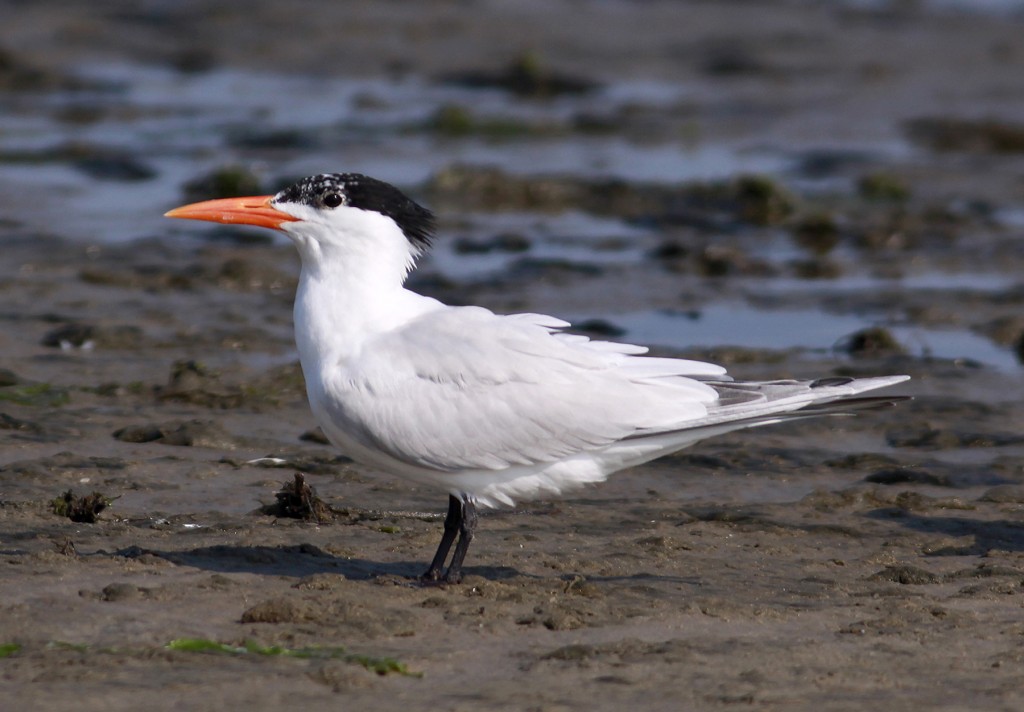When I first started birding I had a tough time distinguishing the two largest terns in our area, Caspian Tern and Royal Tern. After all, they both have big red or red-orange bills and black caps, right? It has become much easier with time and experience, so if you have problems with these species, I’ll share a few photos and tips. But first, here’s a test: are these Royal Terns? Caspian Terns? Or a mix of both? If so, how may are Royals, and how many are Caspians? If you aren’t sure, then read on. The answer will be provided at the end of this post.
First of all, both of these terns are LARGE compared to the medium-sized Forster’s and Common Terns, and enormous compared to the tiny Black or Least Terns. The head-to-tail tern sizes according to Sibley are: Caspian 21″, Royal 20″, Sandwich 15″, Gull-billed 14″, Forster’s 13″ Common 12″, Black 9.75″, and Least 9″. So start with size to narrow down any terns that you see, especially if other terns are in the mix. Caspian averages just an inch larger than Royal, but it’s tough to distinguish them just by size unless they are side-by-side, and even then the difference between the two species is not always apparent.

The two largest tern species stick out in a group of other terns strictly by their size. Here’s two Royal Terns mixed in with and towering above Common, Forster’s and Black Terns.
A second clue can come from their abundance and breeding range. Caspian Terns breed in small numbers here in NJ; Royal Terns do not breed here, with the nearest breeding location being in the Chesapeake Bay region. In the east, Caspian Terns breed mostly in Canada and along the Great Lakes, and therefore can be seen inland in spring when they are migrating through, while Royal Terns are more southerly breeders that are nearly always near the coast. Both species start appearing here in larger numbers in late summer and early fall when they disperse from their breeding grounds or when the Caspians migrate back through. Royal Tern numbers increase first, and Caspians increase later. Although surprises can occur, it’s useful to have expectations, so look up the relative frequency and timing of these species appearing wherever you are birding.
Although expectations can help guide us, ultimately we need to get down to the key identification points. With these species, the most important characteristics are the bill and the cap. The field guides will tell us that the bill of a Royal is huge and orange-red while that of a Caspian Tern is huger and redder. And for younger birds the Royal has a yellow bill while a Caspian has a light orange bill. Really? Can we distinguish red vs orange-red and yellow vs light orange, especially when the lighting can change our perceptions? Surprisingly, the answer is yes, especially with experience or when there is a mixed flock. But another thing to look for, especially using a scope or if you get a close look, is the smudgy tip on the Caspian Tern bill. Look at the photos below for some examples.
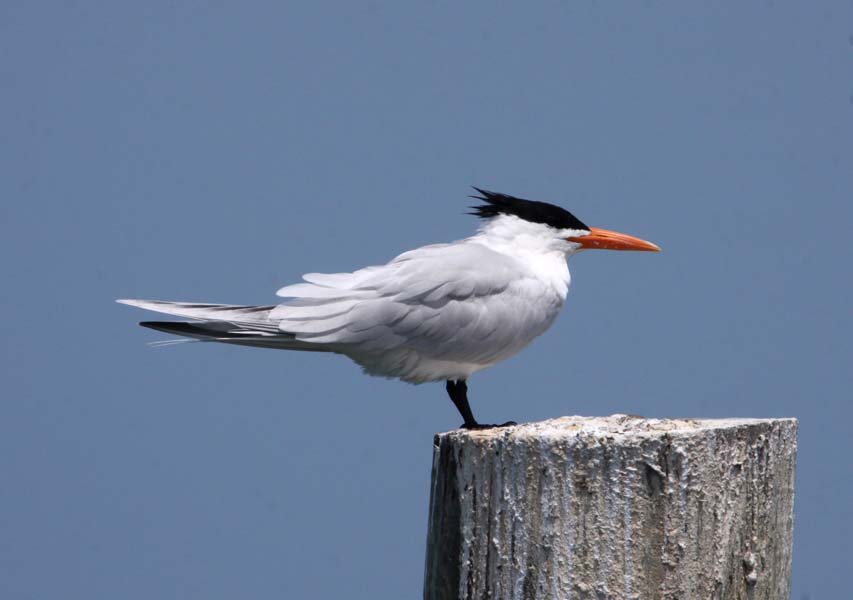
Royal Tern in breeding plumage. Notice the orangey bill and the lack of a smudgy tip. The bill is also less bulky than that of Caspians.
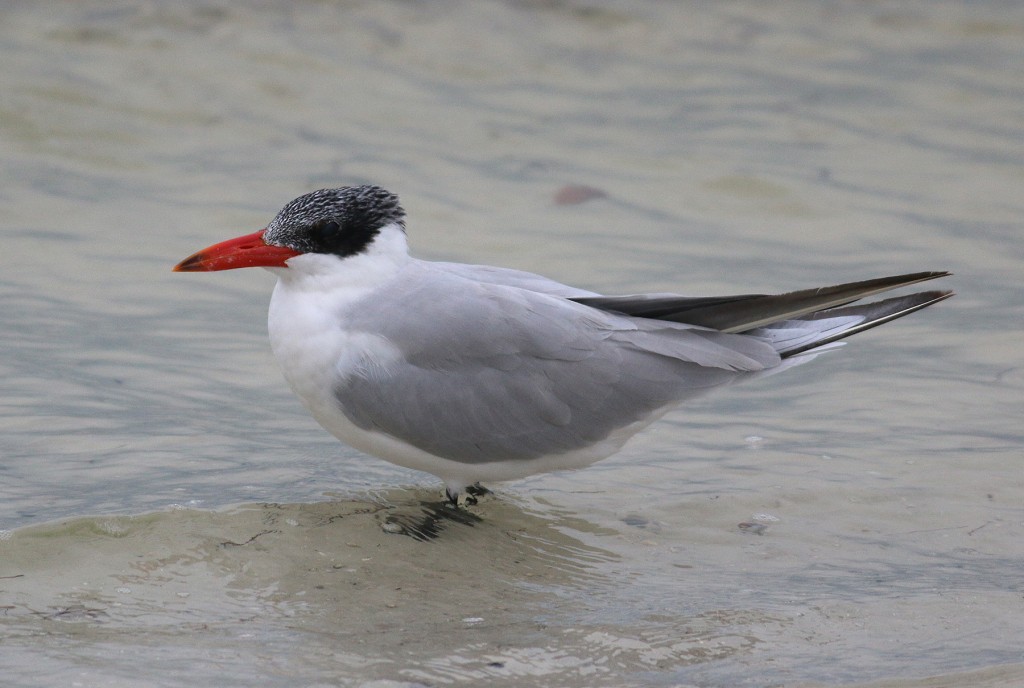
Caspian Tern in near-breeding plumage. The color of the bill is on the red end of the red-orange spectrum, but by itself it’s still tough to judge confidently. The smudgy tip confirms the ID.
Perhaps the easiest distinguishing feature between these species is the cap. As you can see above, both species have all-black caps in breeding plumage, but the Caspian Tern retains that full cap much longer. Royals have the full cap from March to June, while Caspians have it from February to October. Any large terns with a ‘Friar Tuck haircut’ from June through mid-September will be Royals (although the smaller Sandwich Terns have the same look too…see below). The Caspians don’t lose as much of the black either, even late in the season, so they never reach full ‘Friar Tuck’ mode.

Four Royal Terns in late September, The complete black cap is now a ‘Friar Tuck haircut’. They have looked like this since June. Compare with the Caspian Tern photo below taken on the same day.

Three Caspian Terns in late September when they just start to lose their cap. Although there is variability in how much black remains in the cap, they never lose as much of the cap as Royal Terns. The smudgy tip is quite obvious in this close-up photo. Notice that the bill color is only slightly different from the Royal Terns in the previous photo. Look for the smudgy bill tip if you’re not sure.
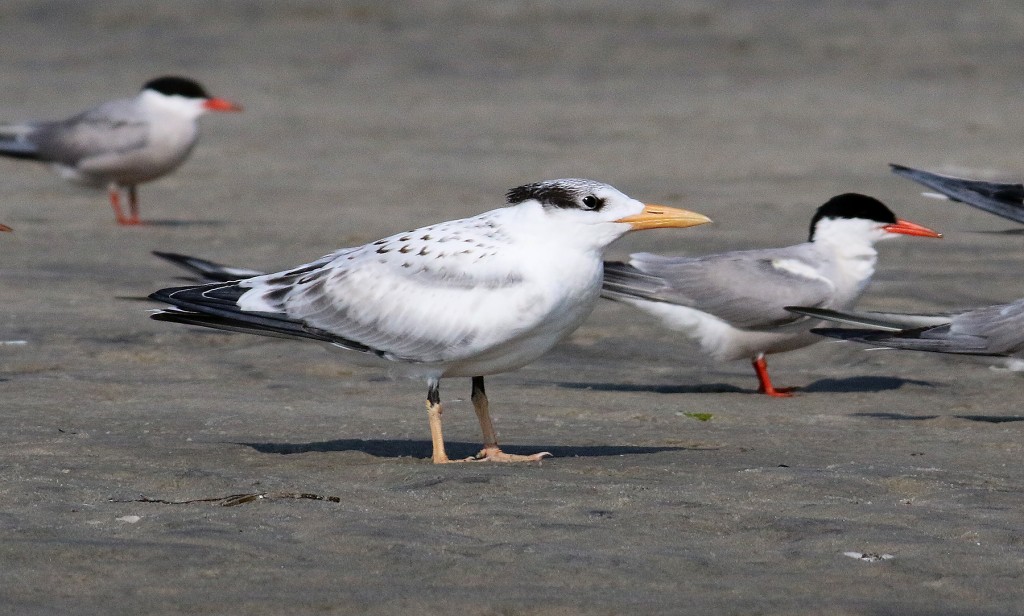
An immature Royal Tern in July. Note the yellow bill, fleshy legs, black tips of the feathers on the back, and the lack of a full black cap. All are characteristics of young Royal Terns.

Look out for Sandwich Terns, which are also larger than our mid-sized terns, and also have a distinct ‘Friar Tuck haircut’. They are much more rare in NJ than Royals, and have a black bill with a yellow tip.
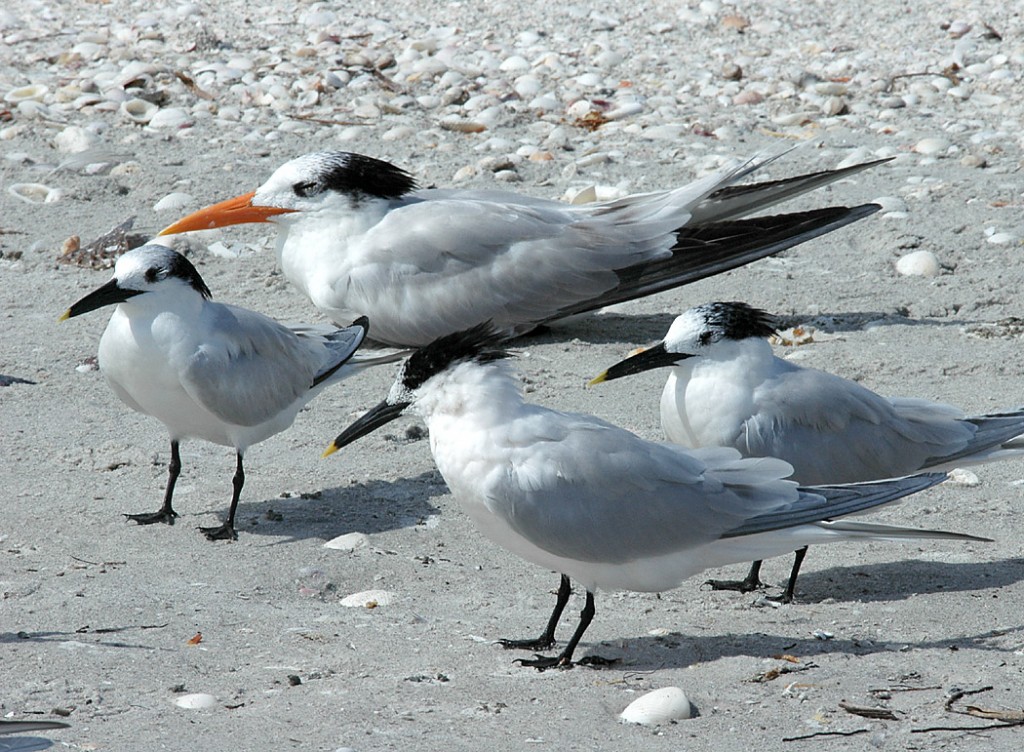
Here we have three Sandwich Terns next to a Royal Tern, to show the size comparison. Look for Sandwich Terns mixed in flocks of Royal Terns.
Good luck trying to find and distinguish these birds. As with all birding, it gets easier with practice. Regarding the quiz photo at the top of this page (taken in August), there are five mature Royal Terns (with the funky haircut and orange bill), two young Royal Terns (with funky haircut and yellow bill), and a single Caspian Tern (with full dark cap and deep red bill) sitting down near the center of the photo. The second photo shows a single adult Royal Tern.

